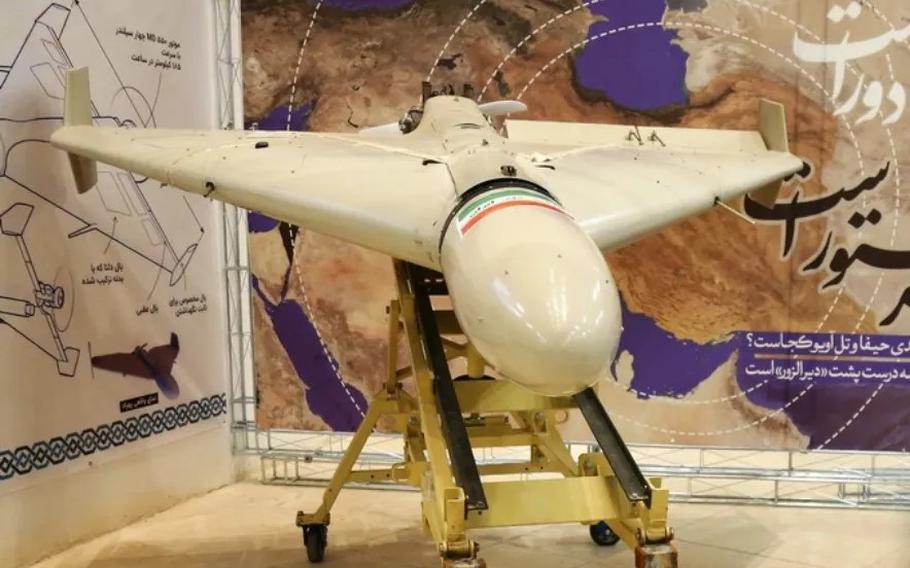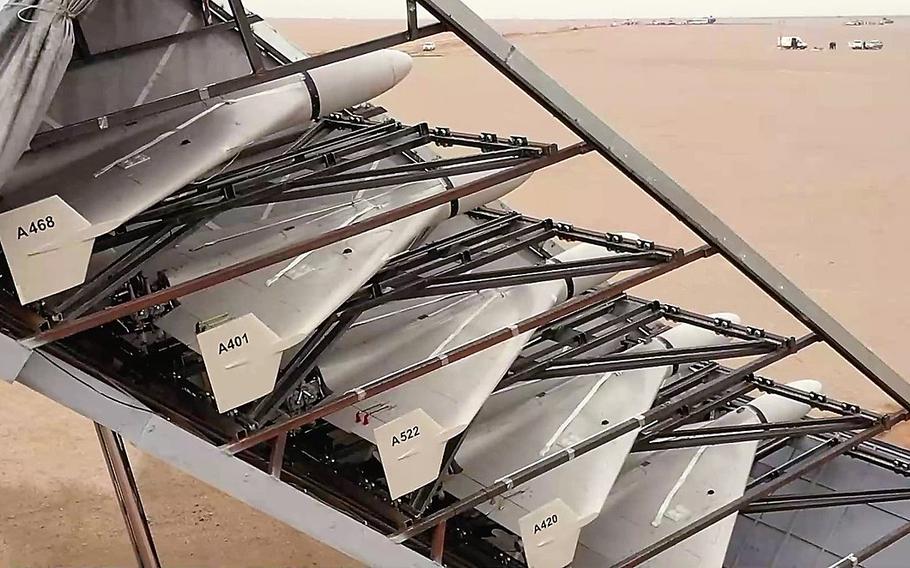
An Iranian Shahed 136 drone is displayed at a defense exhibition in Qom, Iran. (West Point)
Iran’s expansive drone program is giving the U.S. and its allies a lopsided problem: cheap, expendable aircraft that can evade detection and cost much more to shoot down than to build.
The U.S. is relying on a mix of sanctions, interdictions and emerging defensive technologies to blunt the threat posed by Iran and proxy forces like Houthi militants in Yemen. But analysts say the U.S. must move faster to stay ahead of Tehran’s adaptations.
A recent example of Washington’s strategy to counter Iran’s ability to mass produce and export drones came July 31, when the Treasury Department sanctioned five companies and an executive accused of supplying Iran Aircraft Manufacturing Industrial Co., or HESA, with technology.
HESA is a state-owned subsidiary of Iran’s defense ministry that produces the Ababil series of one-way attack drones.
The sanctioned companies were enabling Iran’s plans for attacks on American service members and allies in the Middle East, the agency said in a July 31 statement.
Drones are a relatively inexpensive way to deliver explosives over long distances, said Wolf-Christian Paes, a senior fellow for armed conflict at the International Institute for Strategic Studies.
“And whatever we can do to defend against these weapons systems, in most cases, is a lot more expensive,” he added.

Iranian Shahed 136 drones in a transport container. (U.S. Army)
Iran-backed Houthi rebels in Yemen are perhaps the “most innovative users,” Paes said, and have consistently used one-way attack drones to target both commercial vessels and U.S. Navy ships. Iranian drones also have shown up in Ukraine, where Russia has used them against military and civilian targets.
Iran has worked over the past several decades to master what analyst Behnam Ben Taleblu calls the “unmanned aerial threat spectrum,” which spans mortars, drones and ballistic missiles.
The strategy allows Iran to launch layered attacks that, while often minimally effective, force adversaries to expend costly missiles, said Taleblu, director of the Iran Program at the Foundation for Defense of Democracies.
Such was the case in April last year, when U.S. forces and their allies intercepted a barrage of 170 drones, along with dozens of cruise missiles, that were launched at Israel from Iran and Yemen.
“Even though, hypothetically, the U.S. or the Israelis may be very, very successful when it comes to deterrence by denial, the fact that the U.S. or Israel has to spend more to track, detect and destroy the systems is still notched, at least intellectually, as a win for the Islamic Republic,” Taleblu said.
At the same time, the U.S. is scaling up its own unmanned aircraft programs and funneling resources toward anti-drone technology.
In December, the White House signed off on a strategy to develop counterdrone systems, which former Defense Secretary Lloyd Austin called an “urgent and enduring threat.”
Last month, Defense Secretary Pete Hegseth announced a goal of “domain dominance” for uncrewed aircraft by 2027. The Army has already begun testing out some drone-busting technologies in the field, like signal jammers that disrupt radio frequencies.
Iran manufactures its unmanned aircraft domestically, with low-cost commercial parts sourced globally.
One-way Shahed attack drones, widely used by Russian forces in Ukraine, generally cost about $35,000 apiece, according to the Center for Strategic and International Studies. Paes estimates the cost may be less than $20,000 apiece.
The aircraft are made of light material like fiberglass or plywood that are more difficult to detect on radar. That gives them the element of surprise in some cases, Paes said.
Last month, one person was killed when a Houthi drone exploded in Tel Aviv near the U.S. Embassy branch office. Israeli air defense systems had failed to identify it as a threat.
American sanctions might not be a panacea for Iranian drones, but they can disrupt a key part of the supply chain, including foreign partners, according to analysts.
The U.S. has previously sanctioned drone-linked companies in Russia, Turkey and Germany. The most recent sanctions targeted entities in Iran, Hong Kong, Taiwan and mainland China.
“These designations can be effective if they consistently name, shame or punish all of the front companies … that basically get Western components into Iranian drones,” Taleblu said.
In addition to sanctions, the U.S. and its allies can also focus on intercepting shipments of weapons and parts headed to Iran.
Last month, the Yemeni government captured a large shipment bound for the Houthis that included hundreds of drone engines.
Going forward, tracking developments in Iran’s drones will be key to getting ahead of the curve when it comes to disrupting the supply chain, Paes said.
For example, there are some indications that Iran is looking into the use of hydrogen fuel cells, which would give battery-operated drones a much longer range, he said.
“A large challenge is that we are always just reacting to what is happening,” Paes said. “Usually, by the time we find out that they have a new weapon system that uses this or that … it’s too late.”